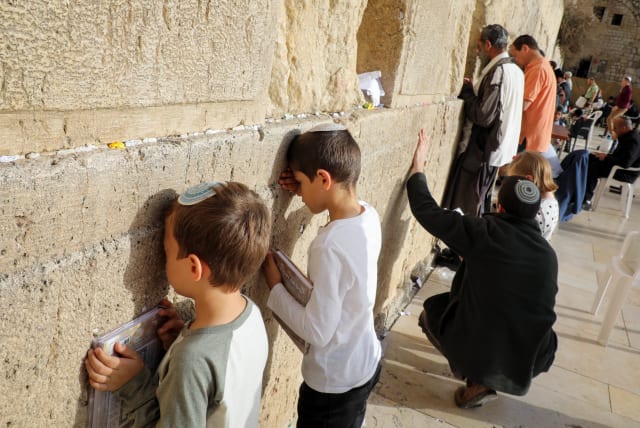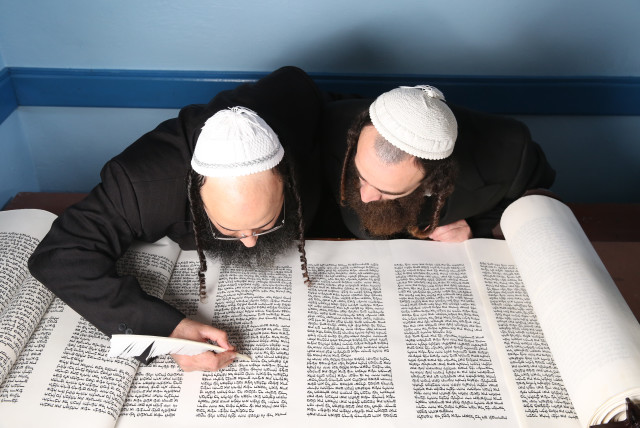Parashat Bamidbar: Prayer sources

Trying to parse through tradition to find the source for Jewish prayers.
The second chapter of the Book of Numbers/Sefer Bamidbar opens:
“The Lord spoke to Moses and Aaron, saying…” (Num. 2:1)
The midrash comments on the pairing of Moses and Aaron in that sentence from this week’s parasha, Bamidbar:
“In 18 passages you find Moses and Aaron placed on an equal footing [when God spoke]. This is related to the 18 benedictions [of the weekday Amidah prayer section]... In 18 passages Moses and Aaron are conjoined; giving a hint for the 18 benedictions, which correspond to the 18 references to the Divine Name occurring in the Shema [Deut. 6:4-9; Deut. 11:13-21; Num. 15:37-41] and in ‘A Psalm of David’ [Psalm 29]. The Three Patriarchs, then, introduced the custom of praying three times a day, while Moses and Aaron and from the above mentioned references to the Divine Name we infer 18 benedictions [in the weekday Amidah].” (Midrash Rabbah Numbers 2:1)
In this midrash, the rabbis are looking for a justification for why the Amidah, the core prayer of every Jewish prayer service, has 18 parts. They also note that we pray three times a day because of the Three Patriarchs. Since the 2nd century CE, after an additional benediction was added to the Amidah, bringing the total to 19 benedictions, the Amidah has continued to be called the “Shemoneh Esrei” (Mishna Berachot 4:3). (On Shabbat and holidays, the Amidah has only seven sections.)
What is the source for the Jewish prayer?
In another midrash, we read:
“Rabbi Hanina said in the name of Rabbi Pinechas, ‘The Patriarchs are mentioned 18 times in the Torah [together], and accordingly the Sages [rabbis of the Mishna, 200 CE, and Talmud, 500 CE,] instituted 18 benedictions in the service.” (Midrash Rabbah Genesis 69:4)
We find further discussions on this topic in the Talmud:
“Shimon HaPakuli arranged the 18 blessings before Rabban Gamliel in their order in Yavne. Rabbi Yohanan said, and some say that it was taught in a baraita [a teaching from the mishnaic period not included in the Mishna]: 120 elders [the Men of the Great Assembly (approx. 4th century BCE to 1st century CE)] and among them several prophets, established 18 blessings...” (Megillah 17b)
We see in this overview a number of different answers to the source of the 18 benedictions of the Amidah. We find a question raised as to why we pray three times a day (with the Amidah and its 18 benedictions as its core). In the midrash quoted above, we also discover:
“Abraham instituted morning prayer, as it is said, ‘And Abraham got up early in the morning to the place where he had stood, etc.’ [Gen. 19: 27]... Isaac instituted afternoon prayer, as it is said, ‘And Isaac went out to meditate in the field at eventide’ [Gen. 24:63]... Jacob instituted evening prayer, as it is said, ‘And he came upon the place, etc.’ [Gen 28:11].” (Midrash Rabbah Numbers 2:1)
In this understanding, the Patriarchs are associated with why we pray three times a day. A very similar example of giving credit to Abraham, Issac, and Jacob for thrice praying each day is found in Genesis Rabbah 68:9. There we find two additional reasons for the three daily times of prayer:
“Rabbi Shmuel bar Nachman said: [the three times we pray correspond to the] three times the day changes. In the evening, a person needs to say ‘may it be Your will, Lord my God, that you will bring me from darkness to light.’ In the morning one needs to say ‘I thank you Lord my God, that you brought me from darkness to light.’ In the afternoon a person needs to say ‘may it be Your will, Lord my God, that just as I merited to see the sun rise, may I merit to see the sun set.’ Another explanation... the rabbis say the prayers were fixed according to the [daily] Tamid sacrifices. The morning prayer according to the morning Tamid offering. The afternoon prayer according to the Tamid of the late afternoon. The evening prayer has no set moment, it was established according to the limbs and fat pieces that were consumed by the fire of the altar.” (Genesis Rabbah 68:9)
Rabbi Shmuel ties praying three times a day to the natural cycle of the day, while the rabbis link them directly to the daily sacrifice in the Temple. In the discussion of why we pray three times a day, we have seen answers that predate the Temple – the Patriarchs and the three natural time periods of the day. We also see an answer that connects the times of prayer to the actual Temple sacrifices themselves.
Returning to the 18 benedictions of the Amidah, there are voices within the tradition that claim the reasons predate the Second Temple, such as the 18 pairings of Moses and Aaron in the Torah (Midrash Rabbah Numbers 2:1). There is also the belief that the Men of the Great Assembly “established the 18 blessings” (Megillah 17b) while the Second Temple stood. And there are those that place the answer after the destruction of the Temple by the Sages (Midrash Rabbah Genesis 69:4). What is fascinating is that while some of these explanations place the 18 benedictions originating while the Second Temple stood, there are those that give the answer before or after the Second Temple.
This despite the history as explained in Jewish Liturgy: A Comprehensive History by Rabbi Ismar Elbogen:
“There can be no doubt that the nucleus of this [Amidah] prayer took shape as early as the Second Temple period; it seems likely that the number of benedictions was already eighteen, at least in the practice of most communities, before the ‘formulating’ of this prayer in Yavneh. This view is nearly universally accepted today.” (Elbogen, p. 37)
One way to understand why there are explanations of why we pray three times a day and why there are 18 benedictions in the Amidah that are not grounded in the Temple is because once the Temple was destroyed, it meant that any justifications associated with the Temple in regard to the daily prayers and the 18 benedictions of the Amidah were weakened. And so to expand the premise of praying three times a day and why there are 18 Amidah benedictions, thinking was broadened.
This is the strength of Judaism – for thousands of years, we have confronted the need for adaptability in the face of new realities. One aspect of daily prayer is the renewal/hithadshut of the self as we experience the multitude of what the day brings us. Rabbi Sylvia Rothschild points out, “The Hebrew verb le’hitapallel, from which the word for prayer – tefillah – comes, means in essence to work on oneself and to judge oneself. So the language of prayer is reflexive... it is about stepping outside of the normal stream of time and busyness and looking at ourselves in order to decide for ourselves.”
Commenting, Dr. Yaakov Elman of Yeshiva University writes, “‘renewal’ refers both to natural/cosmic processes and human ones related both to society and the individual, from daily, monthly, yearly, and seasonal cycles of human resilience and renewal.”
Prayer can help us achieve this hithadshut as a way to adjust and balance our lives through the course of the day as established by the tradition – evening, morning, and afternoon. ■
The writer, a Reconstructionist rabbi, is the rabbi emeritus of the Israel Congregation in Manchester Center, Vermont. He teaches at the Arava Institute for Environmental Studies at Kibbutz Ketura and at Bennington College.
Jerusalem Post Store
`; document.getElementById("linkPremium").innerHTML = cont; var divWithLink = document.getElementById("premium-link"); if (divWithLink !== null && divWithLink !== 'undefined') { divWithLink.style.border = "solid 1px #cb0f3e"; divWithLink.style.textAlign = "center"; divWithLink.style.marginBottom = "15px"; divWithLink.style.marginTop = "15px"; divWithLink.style.width = "100%"; divWithLink.style.backgroundColor = "#122952"; divWithLink.style.color = "#ffffff"; divWithLink.style.lineHeight = "1.5"; } } (function (v, i) { });

